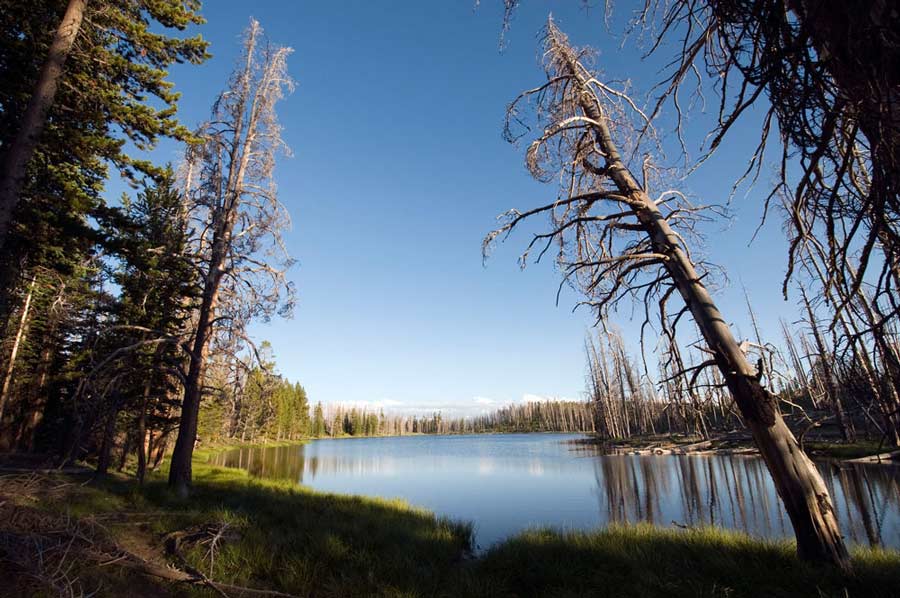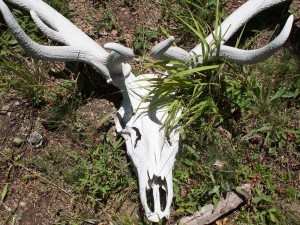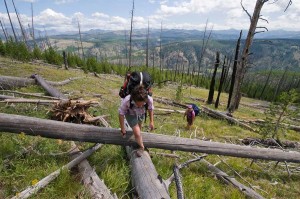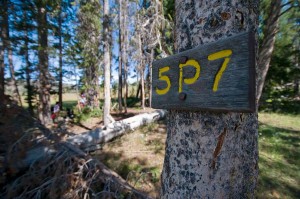
By Kelsey Dayton/WyoFile.com
It wasn’t about the view. Around me were endless dead and down trees; a sight, in fact, I’d grown sick of already. I could have seen the skyline of tree-covered mountains in almost any other forest.
It was about being alone, having endless space in an area that draws more than 3 million people each year. It was about looking out and wondering if anyone else was out there, or if it was just us and bears and wolves and bison, and where those animals might be at the moment.
There are so many things in Yellowstone National Park that can make you feel physically small — the roaring waterfalls, geysers spraying more than 100 feet in the air and bison as big as a small car. But it is in the backcountry that you not only feel small, but also insignificant, a speck in a world that seems to expand into an immeasurable vastness.
I’d never heard of the Mirror Plateau until I read about it in an outdoor magazine last winter. I was intrigued by the idea of the isolation within a place that draws millions of visitors each year. It isn’t just rugged; it’s trail-less. It isn’t just obscure; it’s unknown to most people. It isn’t just untrammeled; overnight travel is limited to only several weeks in the summer and 14 total permits.
I approached my friends Jeannette and Brad Boner about hiking the plateau as a Yellowstone adventure. Brad had Mirror Lake on his list for a photography book he’s working on and helped plan our 35-mile trip that would take us across the plateau and through a Yellowstone seen by the park’s earliest explorers and few others.

Like so many people who live near it, we tend to avoid Yellowstone in the summer. As I sat impatiently tapping the steering wheel at a dead stop in the middle of the road, while the people in front of us hung out car windows with cameras, I remembered why I rarely visit the park in August.
It seemed hard at that moment to imagine we were headed somewhere where we’d most likely be the solitary hiking group. These were among the last people we’d see for days.
The Cook-Folsom-Peterson party first explored Yellowstone in 1869 and traveled the Mirror Plateau, said Lee Whittlesey, park historian. The Hayden Survey of 1871 visited the area next and named Mirror Lake, a generic name for the reflective quality of the lake and from which the plateau took its name.
Then, the entire park was rugged, remote and a mystery. Today, more than 3 million people visit Yellowstone each year. Roads wind through once deserted canyons, and boardwalks provide throngs of tourists easy access to thermal features once seeming an entire world away. Yet the Mirror Plateau remains pristine, changed only in the way of the natural world, trees downed by forest fires and faint bison trails meandering through the debris.
“I wouldn’t call the Mirror Plateau very well explored today,” Whittlesey said. “It is a compass place.”
While other areas of the park developed, the plateau stayed isolated, locked-off from the rest of the park by geography, rivers and mountains, Whittlesey said. A traverse of the plateau is done without the aid of trails.
Philetus W. Norris, who served as the park’s superintendent from 1877 to 1882, opened a trail from the north end of Mirror Plateau through Pelican Valley, Whittlesey said.
The sheer remoteness deterred hikers. The trail was used mainly by poachers, like the notorious Edgar Howell who was eventually captured for killing bison on the plateau and in the Pelican Valley, Whittlesey said. Due to a lack of laws, Howell could only be detained shortly and then released from the park. The incident led to the Lacey Act of 1894, the first federal law to protect wildlife. It still stands today, Whittlesey said.
Other than the Lacey Act and early photographs of Mirror Lake from the Hayden Survey, the plateau has not played a major role the park’s history.
“It just fell off the radar,” Whittlesey said.
Lack of use allowed the landscape to quickly reclaim the trail and the plateau has since remained a trail-less section of backcountry. Most visitors spend time in only about 1 percent of the park, Whittlesey said. Other features of the park eclipse the backcountry. People drive to geysers, view elk from the car and view hot springs from boardwalks.
“That really leaves the backcountry wide open,” he said. In fact, 300 of the park’s waterfalls weren’t discovered until the 1990s. “That says a lot about the remoteness and the lack of trails.”
And nowhere else in the park offers the same rugged terrain and remoteness as the Mirror Plateau. Other areas of the park, like the Bechler area or the Thorofare, offer hard, long hikes mostly free of fellow humans. But even these areas offer a trail system. It is its remoteness that intrigues the few who venture to the plateau, including Whittlesey.
During his first summer in the park in 1969, working as a garbage man, he tacked a topographic map of Yellowstone above his bed. At night he’d stare at it, wonder about the backcountry, what and who, if anyone, was out there. The names of the remote thermal features especially intrigued him, Rainbow Springs and Joseph’s Coat Springs. Little was written on them. No one he talked to knew anything about the plateau area.
“It was the inherent remoteness of the place,” he said. “It just seemed mysterious.”
***
Our trip began from the Lamar Valley, an area known for its abundant wildlife. As we organized our gear, making sure we had easily accessible bear spray, a woman approached with binoculars in hand, pointing off into the distance where she said they’d been watching wolves. The wolves dropped out of sight down a river bank, before we saw them, but wolf sightings from the parking lot seemed like a good start to the trip. We made our way across the valley through dried grass and remnants of fading wildflowers. The valley seemed a dry skeleton of the lushness it might have been earlier in the summer or in wetter years. While the trail began fairly flat, it remained in the open, with little reprieve from the sun. Haze from fire smoke created the deceptive effect of cloud cover, making it seem as if it should be cooler.

We passed a few fishermen heading back to the trailhead late that afternoon. They were the last people we would see for the next few days.
We hiked about 10.5 miles to our campsite that night near the Lamar River. As we neared camp, Brad scrutinized the mountain across the river, looking for weaknesses in tight, new tree growth, trying to scout a path of least resistance. He mentioned creating a back-up plan.
Back-up plan?
I still didn’t understand the arduous trip that lay in front of us, even as Brad re-emphasized we were going into unmarked territory, which meant carefully choosing a route and navigating obstacles. By the end of the second day I’d understand.
***
For some reason I don’t think of Yellowstone as mountainous. I think of it as sitting at a high elevation. I’ve biked through the park from West Yellowstone to Gardiner, so I understand the changes of elevation. I’ve hiked in the park and remember gasping for breath and panting up the trail. I’ve looked at the map, I know there are peaks, but still, I just don’t think mountains when I think Yellowstone.
We looked at the slope in front of us on the morning of our second day. The plan was to hike straight up, about 2,000 feet in two miles. This was different though, than any other steep hike we’d done. The slope was an obstacle course of dead and downed trees that would have been challenging on a flat surface and without a backpack. Parts of the slope were so steep I needed my hands to avoid feeling like my pack would pull me backward.
As I paused for the first of many breath-catching rests, my heart pounding so hard I could feel it throbbing in my temple, I realized, this was a mountain.

That day was our shortest; we only planned about 7.5 to climb to the top of the plateau, cross to Mirror Lake and then drop down to our campsite near Pelican Creek.
Moving was tedious. Walking was dream-like, where you can’t move any faster than slow motion. I’d forgotten my trekking poles and suffered pole envy, watching my friends use theirs for balance and leverage as we hoisted ourselves over trees and used logs like ramps.
At one point, despite the flattened landscape near the top, I looked up and realized I couldn’t see my companions anywhere, even with the aid of standing on a log. I found them a few minutes later and worked to keep better tabs on them as we continued to navigate the downed forest. The forest was disorienting. I was grateful for Brad’s innate sense of direction and map skills.
The Mirror Plateau is a lonely place with only two campsites in the area – one near the headwaters of Opal Creek and the other near Pelican Creek. Each has a fire pit and bear pole. Neither are marked on maps. Even the volunteer who checked us in a the backcountry office was surprised to learn where we were going.
Backcountry camping on the plateau is limited to 14 total permits and only between July 1 and Aug. 15. This is due to the park’s bear management plan, said Ivan Kowski, the park’s backcountry program manager. While there are other areas that are closed during certain times of the year, no other place in the park has such a limited window and allows so few people for overnight travel. The restrictions reduce human impact in the areas that are prime habitat for bears and have a high density bear population.
Yet the area is large. Our trip gave us only a small glimpse of it, we never even passed the thermal features that had first captured the attention of Whittlesey.
While overnight access on the plateau is limited and can be competitive, there are years when not all of the permitted nights are requested. It’s one of the little known corners of Yellowstone, Kowski said.
“First-time visitors aren’t seeking out that kind of trip,” he said.
Day use on the plateau is allowed throughout the year, although the challenges of getting there limit hikers. Most are base-camped somewhere near the plateau, and might venture onto the plateau or visit Mirror Lake for a day. Day use isn’t tracked, so it’s hard to know exactly how many people travel the area, he said. But it isn’t many.
As I neared the top of our climb, I looked out and saw a different Yellowstone. Peaks surrounded us, the world stretched out unending in the sky, and below, the river from where we’d came was only a thin line barely visible.
I took it in for a moment and then turned, not wanting to lose sight of my friends again.
We arrived at Mirror Lake that afternoon. At first glance it wasn’t anything special, other than a reprieve from the exhaustive day. Everything hurt. I’d worn shorts and my legs were shredded with thin lines of scratches. My feet hurt from the uneven terrain. Even my arms and wrists hurt from hoisting my body up and over so many logs.
Sitting on the banks of the lake, there was a sense of something special, like being in on a secret few others know. I thought about those early explorers, how the lake was just another place in a rugged unexplored wilderness, while today it is one of the few places left that way.
Across the lake a large bison rumbled into view. It caught sight of us, paused, turned and sprinted away. We watched, surprised at how skittish it was compared to the animals that graze roadside in the park, acknowledging people only when they get too close.
This bison, it seemed, didn’t see many people.
***
On our third day, we rejoined the park’s trail system, which made the going much easier. But by then I was tired and my feet blistered and the relatively flat walk through the forest still seemed like a slog. It was also our longest day, from our second campsite to the third was about 11.5 miles. Crossing a meadow we could see smoke burning from a forest fire.
We woke early our fourth day for our eight-mile hike out. By then, the blisters on my feet surpassed uncomfortable and I was in pain, dreaming only of not having to walk on them. We were ready to rejoin the world of cheeseburgers and cold beer. So my stomach knotted when we found our route blocked with a sign saying the trail closed the day before due to bear activity, the first sign of bears we’d seen on the trip. The detour didn’t add much mileage and we were still on track. But a few miles later we reached another closure. This detour changed our exit to the popular Artist Point, which was just up the road from where we had left the car and planned to emerge.
We could tell we were nearing civilization, noting a cigarette butt on the trail. As I limped along, ready for food, I made time to pause and take in the sights that drew so many people, looking down to the Yellowstone River. The walls of white and red, shocking colors after days of only pine green, charred black and wooden brows and grays, the landscape so different than where we’d been.
I heard the people first, the ringing of bear bells, clapping and purposefully loud talking to avoid bears. Then they appeared on the trail, carrying water bottles, speaking foreign languages and greeting me in accents I tried to identify.
“Was it worth it?” one asked.
I answered before I realized they were talking about the short loop trail we currently shared, despite my swollen legs and fatigue.
“Oh yeah.”
If you go…
Any overnight backcountry use in Yellowstone requires a permit. The park starts taking requests for backcountry camping at the beginning of the calendar year. Requests are processed by lottery April 1 and requests made after are met on a first-come-first-serve basis.
Kelsey Dayton is a freelance writer based in Lander. She has been a journalist in Wyoming for seven years, reporting for the Jackson Hole News & Guide, Casper Star-Tribune and the Gillette News-Record. Contact Kelsey at [email protected]. Originally published at WyoFile.com and reprinted with permission.

